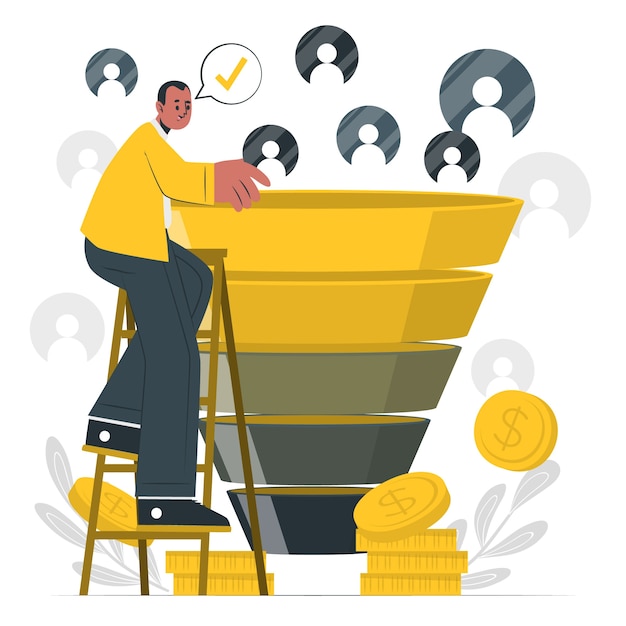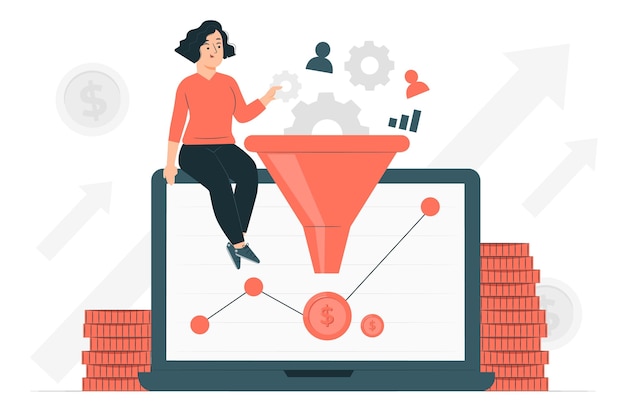Best Visual Marketing Ideas 2025
You must identify techniques that work as marketing best practices tend to change. While predicting how marketing will evolve is impossible, a few situations will...
Puiblished: Apr 1, 2024 Updated: Apr 29, 2024
A lot of marketing theories have attempted to explain the customer journey. Among these theories, the most popular ones are AIDA and the sales funnel. Many marketers also adapted the AIDA model to the sales funnel to clarify the purpose of each of the three phases.

A sales funnel explains the prospect’s journey from awareness to action. Sales professionals use sales funnels to track the prospect’s journey towards the end goal – the bottom of the funnel. During the process, the sales professionals and marketers attempt to remove hindrances and each prospect’s progress toward the close, stepping in to remove blockers and address needs so that they buy the right solution as quickly and smoothly as possible.
Like a funnel or an inverted triangle, this theory signifies a large number of prospects entering the start, but the number of people becomes lesser with each stage.

While funnels typically have three stages, not all prospects go through all the stages before making the decision to take action. Some prospects jump straight from the first phase to action, while others take a bit of time in the middle of the funnel before progressing to the end and finally taking the required action.
So, the customer journey is non-linear. But that doesn’t make the funnel irrelevant, even in today’s world. The easy-to-understand funnel concept is what makes the sales funnel one of the most used approaches to both marketing and sales in organizations all over the world.
Marketing funnels start with an unaware audience and end with an audience that is aware of the product and engaged with the brand. The sales funnel follows this – the journey that prospects take from initial engagement to final action.
So, from a completely unaware audience to creating leads is the marketing funnel and beyond this is the sales funnel.
Even though many professionals argue about the relevancy of a funnel in a non-linear sales journey, it is still helpful for many businesses. A clearly defined funnel allows marketers to create strategies relevant to each stage. It not only helps create prospective leads for the business but also directs resources strategically to convert these leads to customers.
Many marketers also use the funnel along with marketing and conversion metrics to make better marketing decisions. In turn, this helps companies to gather more customers and get most of them through the next stage.
The sales funnel process looks like an inverted triangle. It comprises three stages – top, middle, and bottom.

The top of the sales funnel is the widest. It catches the prospects, which will then sieve through to the next stage. The higher the number of leads at the top of the funnel, the higher the chances of converting them into customers.
The top of the funnel means introducing the customer to the brand. According to the AIDA model, the awareness stage is at the top of the funnel.
But before marketers develop a generalized strategy to introduce the brand, it is important to assess which stage of awareness the audience is on and what their pain points are.
Let’s consider the example of weight loss supplements. The audience for this product is already aware of many other brands in the category. Many people in the audience must have tried several other weight loss products. In this case, introducing them to a product with similar ingredients and promising the same benefits at the top of the funnel won’t work.
A top-of-the-funnel strategy, in this case, would be defining a Unique Selling Point (USP) to convert members of the target audience to prospects.
Some of the prospects might learn about the product and decide not to go with it. Not all prospects move to the middle of the funnel. Among these, some jump directly to the action stage, while others need a bit more convincing to take the desired action.
The interest and desire stage of the AIDA model is classified as the middle of the funnel. If the product is relevant to the audience at the top of the funnel, they might make an effort to search more about the product. When a brand launches a sponsored post, prompting the target audience to make a swipe or go to the bio to follow the link, the number of people who click through is in the middle of the sales funnel.
It is up to the marketers and sales professionals to make the transition as smooth as possible. If the prospect has to work hard or invest their time and effort, they might not progress through the funnel quickly. For instance, swiping up to visit a link requires less effort than going to the profile and clicking the link in bio.
Email marketing
Email marketing is also an effective middle-of-the-funnel tool. It is a traditional but time-tested tool for sales funnels. Prompting customers to sign up for an email list is a top-of-the-funnel technique while following emails and prompting users to visit the website, attend a webinar, or watch a video through emails (when the final action required is a purchase) is a middle-of-the-funnel technique.
Another middle-of-the-funnel sales technique is retargeting the audience through social media advertisements. In this digital age, retargeting through algorithms is a great way to build on prospects in the audience.
![]()
The bottom of the sales funnel is the final strategy to prompt customers to make a purchase or take action.
Within an email, taking an action like registering for a webinar or watching a YouTube video is a bottom-of-the-funnel technique. So, in an email, the marketers attempt to use a funnel strategy by first building interest and then instigating the reader to take action – watching a video.
Discounts and creating a sense of urgency and scarcity is another bottom-of-the-funnel technique that pushes the prospects to make the decision.

A sales funnel is not just a way to define the customer’s journey. The definition of the customer journey is just the starting point for sales funnel management.
To build a successful sales funnel, it is important to first assess the target audience, then define the goals, determine the sales funnel metrics, nurture leads, and finally, make an offer to close the deal.
To better understand how to build a funnel strategy, here are the steps in detail:
The first step to building a funnel strategy is taking note of the knowledge level and pain points of the potential customer. If the customer has already tried many similar solutions, the pain point would be why the product or solution didn’t work for them.
On the other hand, if the customer is unaware of the solution to their problem, the strategy to address their pain points would be different.
Listing these problems, the target audience’s behaviors, and their knowledge level can help you to devise a solid strategy that works wonders for your business.

Once you are aware of the target audience, their needs, and their pain points, the second step is to define the goals. In the audience assessment, you will also find where to reach the audience. The goals are defined based on the platform and audience interest. This step is a sketch of the funnel – a concept of what action you want the customer to take.
After defining the goals, you will be in a position to create a top-of-the-funnel offer. If the audience has already tried similar products, they will not be willing to pay for a solution immediately. In this case, building their interest by offering them something of free value could be a top-of-the-funnel strategy. Another ToFu offer could be making them subscribe to a mailing list through lead magnets, which means offering something valuable in exchange for their emails and other details.
Once the audience is in the funnel, nurturing them is the middle of the funnel strategy. Offering them more free value or proving them of your authority in the industry are great ways to nurture the leads. For a weight loss solution, sending testimonial videos could be a way to build trust with the audience.
At this point, many people might have taken action already. However, according to the sales funnel, a final push or the bottom-of-the-funnel strategy is what converts the prospects into customers. A push like a discount or a sense of urgency could be a deal closure.

For instance, limited seats left in a course or a 30% discount for a limited-time offer could be the final push needed to make the audience purchase the product.
The last but most important step in the sales funnel strategy is assessing the sales data. Every strategy in the sales funnel is a test and trial. Some strategies might work, while others might not yield good results. At times, even thorough research on the target audience might not result in a good sales funnel. However, conversion stats can help refine and improve the sales funnel.
Some conversion statistics are:
Now that you’ve understood the process of developing a sales funnel let’s explore some examples to assess how sales funnels work in the real world:
Email marketing is considered a traditional sales funnel. Prospects who sign up for the mailing list are already at the top of the funnel because they are aware of the product. However, when you’re cold-emailing prospects, the initial emails are included at the top of the funnel.
Many times, emails are automated sales funnel sequences. They are strategically crafted to welcome the lead into the funnel and push them through to the bottom of the funnel.
Emails are still one of the top tools to convert prospects into customers. However, this tool is best suited for a B2B sales funnel where articles and whitepapers are shared as valuable resources to prospective customers.
Sponsored ads on social media are a great example of a funnel. If you engage with the ad, like clicking on the given link or messaging the business, you have already become a lead. Retargeting ads on social media websites like Facebook is a great way to engage an audience that has shown interest – meaning they are potential customers that could be converted into customers.
Many big enterprises, including Audible by Amazon, Spotify, and Netflix, offer 30-day trials to customers. During the trial, they get a chance to assess the quality of the service before making the purchase. However, getting a customer’s payment information for a 30-day trial still needs some level of awareness. So, the people who subscribe for the 30-day trial know about the brand or are willing to make a purchase. So, they might be classified as the middle of the funnel or the bottom of the funnel audience.
Many YouTubers have created free tutorials for their YouTube audience. Envato Tuts+ is a YouTube channel dedicated to free tutorials from experts in the field. They also direct their YouTube audience to their website, where they can browse through thousands of other tutorials. But their paid product is the Envato Market. A place where they sell templates to beginners and even professionals. You could even subscribe to their unlimited plan. Once subscribed to the monthly plan, you can access millions of creative assets without paying for each one of them individually.
An eCommerce sales funnel could start with a Google search. eCommerce companies invest thousands of dollars in SEO strategies to rank at the top when users search for relevant keywords. Another top-of-the-funnel strategy is offering free delivery to customers on their first order. In this case, the sales funnel is not a triangle but a loop that aims to increase the customer’s lifetime value rather than just make a single sale.

The bounce rate, abandoned cart rate, and reorder rate are a few metrics to measure the success of the sales funnel for your business in the eCommerce industry.
An effective sales funnel is one that converts a high number of prospects into customers. A good sales and marketing funnel is created only when you understand your customer’s pain points and the journey they go through before making the final purchase decision.
Here are some tips for you to create a strategy that maximizes the benefits of a sales funnel:
The first and most important step before creating a sales funnel is understanding the customer and their buying behavior. Learning about their habits, behaviors, and even what they do in their spare time is critical to creating a funnel.
For instance, if mothers are a company’s target audience, their favorite places to dine out, where they have discussions, and the problems they face would reveal the starting point for the sales funnel. Many mothers prefer sharing their problems on Facebook groups. Asking them to participate in an online contest in the group could be a successful sales funnel technique.
Once you know about your customer, it is important to personalize their journey. For instance, knowing about your target audience’s habits and pain points could help you create a sales copy that directly speaks to them.

For example – people who struggle with losing weight look older than they are. Addressing this pain point in your sales copy with a story could help engage them rather than just using marketing jargon and salsey language.
A personalized approach with your target audience might convert a number of your prospects into customers. But if not, it is important to optimize your sales funnel because converting your prospects to the middle of the funnel and, finally, propelling them to make the final decision can be quite challenging. So, only one email and ad won’t be enough to gain a prospective customer’s attention and build desire.
Engaging them through different methods, like a series of videos or interactive blogs and ads could help them move through the funnel because these methods help build trust and credibility with the customer.
Building a successful sales funnel is a series of trials and errors. This is the reason why sales statistics are quite important during the process. Companies spend years building email sales funnels to automatically turn prospects into customers. Others create email copies according to their customers and the emails that generate the most conversions.

The sales funnel shows that the customer’s journey ends once they turn from prospects to customers. However, retaining and engaging customers with the same or other products is important to a company’s profitability. So, many prospects who turn to customers then become prospects for other products in the company’s portfolio, which they perfect through trial and error.
Sales funnels are one of the most used tools by marketing and sales teams. These funnels allow marketers to develop effective marketing messages that convert more potential leads into customers.
A sales funnel is also a tool that simplifies complex marketing concepts into workable and effective strategies.
This sales funnel guide covers the customer’s journey from start to finish, the best practices for sales funnels, and real-world examples. These resources will help you improve your sales processes and create marketing messages after gaining insight into your target customers.
Pimberly’s product information management (PIM) system is a great tool to help you manage your traffic through your sales funnel and build trust with the customer. It is especially useful to increase your product’s visibility, thus widening your funnel and converting the audience from having an interest in your products to desire and action.


